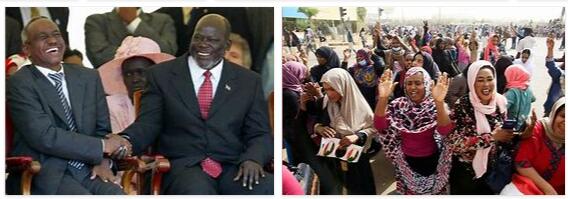Population
According to estimates by international organizations, the population of the Sudan in 1998 amounted to 28,292. 000 residents. Population growth continues to be very strong: in the period 1990 – 95 the birth rate was around 40 ‰ (in 1970 – 75 it was 45 ‰), while the death rate, in the same period, stood at 13 ‰ (was from the 17th century during the seventies). Life expectancy at birth is still quite low and barely reaches 56 years.
The great majority of the population lives in rural regions (75 % in 1995) and a not insignificant part, especially in the north-eastern areas, maintains the nomadic way of life. The greatest concentration of residents is found in the central-eastern section of the country, at the confluence of the Blue Nile and the White Nile, where the three main cities of the South face each other: the capital, Khartoum (924,500 residents In 1993), Omdurman (1.267.100) and Khartoum North (879.100). Relatively high densities are then found in the northern region of Nubia. Other cities exceed 200. 000 pop.: Port Sudan (305. 400), Kassala (234. 300), Niyālā (228 800), Al-Ubayyid (228 100).
Economic conditions
Sudan is a poor country, mainly rural, where development prospects are limited by natural, anthropogenic and economic factors. Political instability and internal unrest, coupled with too high a rate of population growth, drought, high inflation and huge external debt, have made the country’s economic recovery particularly difficult. The process of Islamization has also contributed to alienating – with the sole exception of some Arab countries – the sympathies of many international creditors. Thus, two initiatives considered by the government to be important for the future of the S had to be stopped: the construction of the Jonglei canal, indispensable for the improvement of irrigation, and the exploration campaigns of the subsoil in search of oil resources.
Until the early seventies the Sudan was a country in conditions of great backwardness, but its economy was substantially in equilibrium. The fall in the prices of cotton and other agricultural products on international markets, the long period of drought that has hit this part of the African continent, as well as an expensive development program undertaken by the government, have caused a growing imbalance in the accounts with the abroad. At the end of the nineties the trade balance was heavily in deficit and the weight of the foreign debt had become increasingly heavy; over the years, the worsening of the political crisis and the persistence of unfavorable climatic conditions have made the country increasingly dependent on international aid.
The Sudanese economy has remained focused on agriculture. This productive sector, in addition to employing well over half of the active population, feeds most of the modest industrial activities and contributes less than 50 % to the formation of the GDP. Overall, the country is not self-sufficient from a food point of view and therefore has to resort to the importation of large quantities of food, the distribution of which in the various regions of the interior is hampered by the insufficiency and poor condition of the communication routes. Furthermore, in the southern regions the persistence of the civil war makes it practically impossible to supply the population with food.
Alongside crops intended for self-sufficiency (sorghum, millet, corn, wheat, potatoes, cassava, etc.), Sudanese agriculture contains numerous industrial products or, in any case, intended for exports. The main crop of the irrigated regions is cotton which, despite the reduction in the cultivated area, continues to represent about one fifth of the country’s exports. Other products include sesame (in part also intended for internal consumption) and peanuts (of which Sudan is the fourth largest producer in Africa). From the forest patrimony the Sudan gets the arabic gum, of which it is the first world producer; however, the international demand for this product undergoes considerable fluctuations due to the entry on the market of new producers.
In order to decrease dependence on imports, sugar cane was introduced, to which some publicly owned refineries are connected. The prospects for strengthening the primary sector are linked to the expansion of irrigated areas and depend on the agreements with Egypt for the use of the Nile water: currently almost 2 million ha are irrigated, half of which in the Gezira region (between the White Nile and the Blue Nile). Livestock farming constitutes an important item of exports and, despite the drought has limited the expansionary capacity of the sector, the livestock population is increasing.
In the context of the Sudanese economy, the industrial sector still plays a marginal role, and its contribution to the formation of GDP is modest (about one seventh). The most important productions concern the processing of cotton (mainly concentrated in the Gezira) and peanuts, and the refining of sugar. The sector went through a period of crisis after the nationalizations of 1971 ; starting in 1988, a privatization and conversion program financed by the IMF and the World Bank was initiated. The process accelerated in the early 1990s, coinciding with the opening of the country to international investment and the establishment of four free zones (Porto Sudan, Ǧūbā, al-Ǧanayya and Malūṭ).
There are many mineral resources, but the scarcity of capital, hostility towards Western companies and the civil war have made their exploitation difficult. Oil fields have been located in various parts of the country (in the South-West, on the southern borders with Libya and in the Nile valley); on the coast, near Suwākin, natural gas fields have been found. Other mineral resources include marble, mica, gypsum and chromite, near the border with Ethiopia. Some foreign companies are interested in the reopening of the Hassai gold mines (on the hills overlooking the Red Sea).
